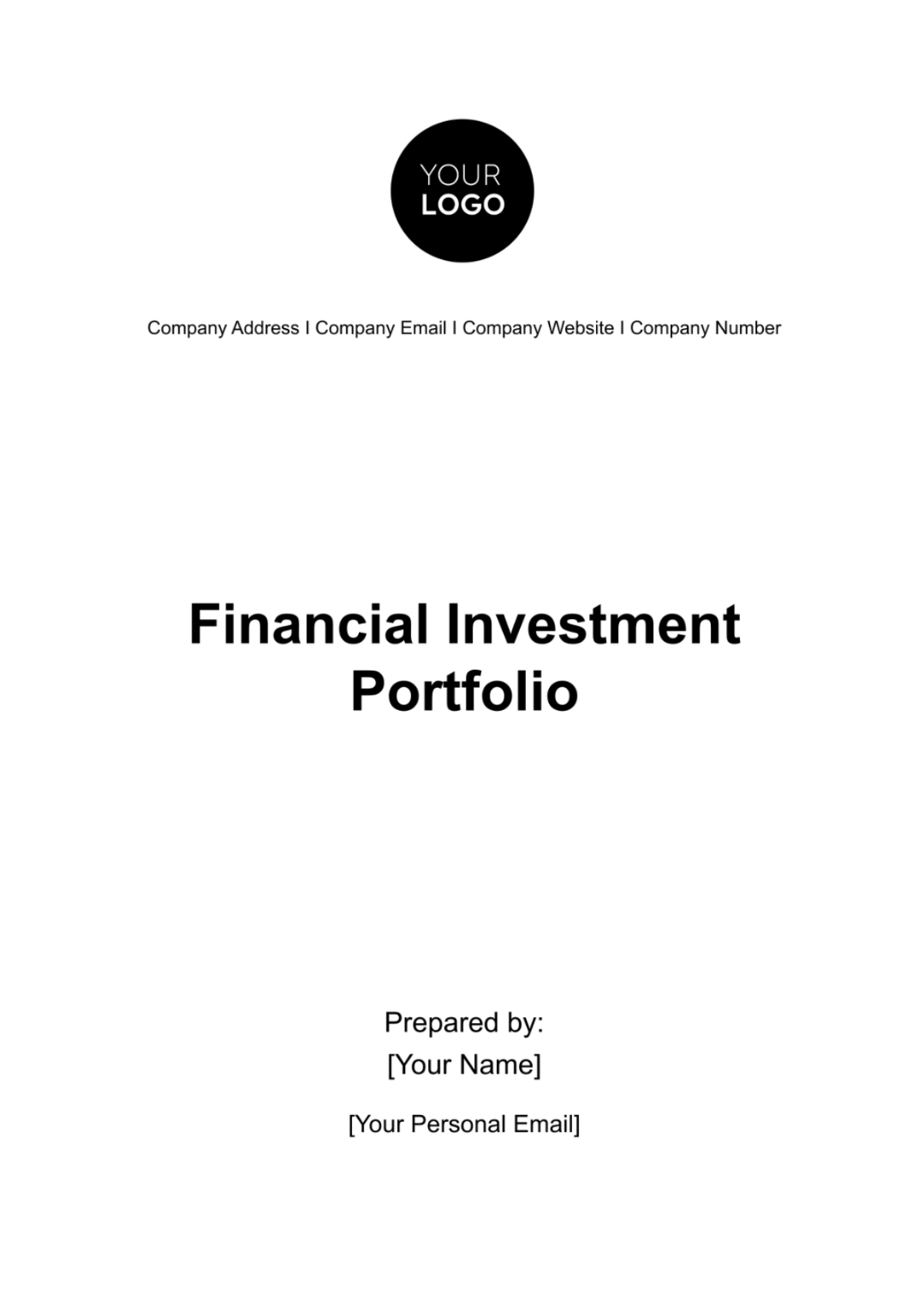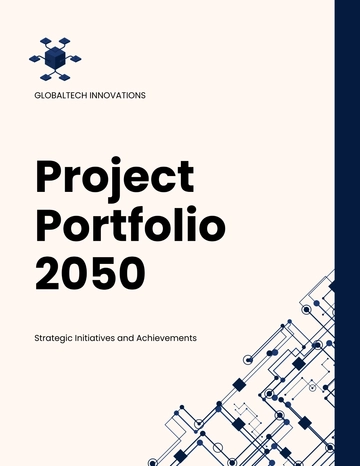Free Financial Investment Portfolio

[Your Name's] Comprehensive Financial Investment Portfolio
Creating a financially sound future is the objective of this portfolio. This creative, professional, and comprehensive portfolio aims to ensure a steady growth of wealth while minimizing risk. It encompasses a well-drafted plan for asset allocation, diversified investment holdings, performance analysis, risk management, and diversification strategy.
TABLE OF CONTENTS
I. Executive Summary
II. Asset Allocation
A. Equities (50%)
B. Bonds (30%)
C. Real Estate (10%)
D. Alternative Investments (10%)
E. Rationale
III. Investment Holdings
A. Equities
B. Bonds
C. Real Estate
D. Alternative Investments
IV. Performance Analysis
A. Portfolio Performance
B. Benchmark Comparison
C. Performance Metrics
V. Risk Management and Diversification Strategy
A. Risk Profile Analysis
B. Diversification Strategies
C. Risk Management Measures
I. Executive Summary
Overview
The portfolio is a carefully curated collection of diverse investment instruments, reflecting a strategic approach tailored to meet our long-term financial aspirations. It encompasses a broad spectrum of assets, ranging from traditional stocks and bonds to more specialized real estate and alternative investments. Each component has been selected based on rigorous analysis, ensuring compatibility with our overarching investment philosophy. This portfolio is not just a financial arrangement but a reflection of our commitment to disciplined and informed investing, aimed at navigating various market environments while seeking sustainable growth.
Investment Goals and Objectives
Central to this portfolio is the objective of achieving steady, sustainable growth while effectively managing risk exposure. We aim to strike a harmonious balance between capital appreciation and income generation, catering to both short-term income needs and long-term wealth accumulation. This dual focus is designed to navigate through market cycles, maximizing returns during favorable conditions and providing stability in more challenging times. The goals set forth in this portfolio are ambitious yet achievable, rooted in a deep understanding of market dynamics and a commitment to prudent financial stewardship.
Summary of Asset Allocation
The portfolio exhibits a thoughtful asset allocation strategy, balancing between growth and security. With 50% allocated to equities, we aim to harness the growth potential of the stock market. The 30% allocation to bonds provides a stable income stream and cushions against market volatility. Real estate investments, comprising 10%, add another layer of diversification, offering potential for both income and value appreciation. The remaining 10% in alternative investments is aimed at exploring opportunities outside traditional markets, potentially enhancing returns and further diversifying risk. This allocation is the culmination of strategic planning, aimed at aligning with our investment goals and risk tolerance.
II. Asset Allocation
This section outlines our comprehensive approach to asset allocation and investment strategy, detailing guidelines, strategies for different asset classes, and criteria for investment selection. It emphasizes a disciplined and strategic approach to constructing and managing the investment portfolio.
A. Equities (50%)
Diversified across sectors and geographies, focusing on blue-chip and growth stocks.
Sector/Geography | Description |
Blue-Chip Stocks | Investments in large, established companies known for financial stability and consistent growth |
Technology Sector | Exposure to high-growth technology firms, capitalizing on innovation and market trends. |
Emerging Markets | Investments in emerging market equities for higher growth potential. |
Healthcare Sector | Allocation to healthcare stocks, benefiting from demographic trends and innovation. |
International Diversification | Diversifying globally, reducing dependence on any single market's performance. |
B. Bonds (30%)
Comprises government and high-grade corporate bonds, balancing the portfolio's risk.
Type | Description |
Government Bonds | Low-risk investments in stable government securities. |
Corporate Bonds | Investment in high-grade corporate bonds for better yields than government bonds. |
Municipal Bonds | Allocation to municipal bonds offering tax advantages. |
Short-term Bonds | Inclusion of short-term bonds for liquidity and reduced interest rate risk. |
Diversified Maturities | Bonds with varied maturities to manage interest rate risks and yield opportunities. |
C. Real Estate (10%)
Investments in REITs and property funds for steady income and diversification
Type | Description |
REITs | Real Estate Investment Trusts for diversified exposure to real estate markets. |
Commercial Real Estate | Investments in commercial properties for income and value appreciation. |
Residential Properties | Allocation to residential real estate for stable rental income. |
Property Funds | Investment in property funds for diversification within real estate |
Global Real Estate | Exposure to global real estate markets for geographical diversification. |
D. Alternative Investments (10%)
Includes private equity and commodities for higher potential returns.
Type | Description |
Private Equity | Investments in private companies for potential high returns. |
Commodities | Exposure to commodities like gold, oil as a hedge against inflation and market volatility. |
Hedge Funds | Allocation to hedge funds for differentiated investment strategies. |
Venture Capital | Investment in start-ups and early-stage companies with high growth potential. |
Specialized Funds | Funds focusing on niche sectors or innovative themes. |
E. Rationale
The portfolio’s asset allocation strategy is meticulously designed to strike a balance between growth and risk mitigation. Equities offer growth potential, bonds provide stability, real estate adds income and further diversification, while alternative investments present opportunities for higher returns. This blend is dynamic and adjusted according to market trends and economic forecasts, ensuring the portfolio remains aligned with our investment objectives and responsive to global economic shifts.
III. Investment Holdings
This section provides a detailed overview of the investment holdings within the portfolio, broken down by asset class. Each holding is listed with specific information, offering a clear view of the portfolio's composition and current value.
A. Equities
List of stocks with details such as number of shares, purchase price, and current market value.
Stock Name | Number of Shares | Purchase Price | Current Market Value |
Apple Inc. | 500 | $120 | $150 |
Microsoft Corporation | 300 | $200 | $250 |
Amazon.com, Inc. | 200 | $1,500 | $1,800 |
Tesla, Inc. | 100 | $600 | $700 |
Johnson & Johnson | 400 | $130 | $160 |
B. Bonds
Detailed information on each bond holding, including issuer, interest rate, and maturity date.
Issuer | Interest Rate | Maturity Date | Face Value | Current Market Value |
U.S. Treasury | 2.50% | [Year] | $10,000 | $10,500 |
IBM Corporate Bond | 3.00% | [Year] | $5,000 | $5,300 |
City of New York Muni | 2.00% | [Year] | $7,000 | $7,200 |
Apple Inc. Bond | 2.80% | [Year] | $6,000 | $6,400 |
General Motors Bond | 3.50% | [Year] | $4,000 | $4,250 |
C. Real Estate
Overview of real estate investments, with details on property type, location, and valuation.
Property Type | Location | Size (sq ft) | Purchase Price | Current Valuation |
Commercial Office | New York, NY | 10,000 | $1,000,000 | $1,200,000 |
Apartment Complex | Austin, TX | 30,000 | $2,500,000 | $3,000,000 |
Retail Space | Chicago, IL | 5,000 | $800,000 | $850,000 |
Industrial Warehouse | Atlanta, GA | 20,000 | $1,500,000 | $1,700,000 |
Residential Home | San Francisco, CA | 2,000 | $1,200,000 | $1,400,000 |
D. Alternative Investments
Information on holdings in private equity funds, commodities, etc.
Investment Type | Fund/Asset Name | Amount Invested | Current Valuation |
Private Equity Fund | Tech Growth Fund | $500,000 | $600,000 |
Commodities | Gold Futures | $200,000 | $220,000 |
Hedge Fund | Global Strategies Fund | $300,000 | $330,000 |
Venture Capital | Startup Innovators Fund | $400,000 | $500,000 |
Specialized Fund | Green Energy Fund | $250,000 | $280,000 |
IV. Performance Analysis
This section presents an in-depth analysis of the portfolio’s performance, benchmark comparisons, and various performance metrics. It's designed to offer a comprehensive understanding of how the portfolio has fared over time, in both absolute terms and relative to standard benchmarks.
A. Portfolio Performance
Analysis of the overall performance, including total return over the last year and since inception.
Time Period | Total Return | Comments |
Last Year | 8% | The portfolio saw a solid return, outperforming initial projections primarily due to strong equity performance. |
Since Inception | 6% annually | Over the long term, the portfolio has delivered consistent returns, aligning closely with the targeted growth objectives. |
B. Benchmark Comparison
Comparison of portfolio performance against relevant benchmarks, such as the S&P 500 for equities and Barclays Aggregate Bond Index for bonds.
Asset Class | Portfolio Return | Benchmark Return | Benchmark Name |
Equities | 10% | 9% | S&P 500 Index |
Bonds | 5% | 4.50% | Barclays Aggregate Bond Index |
Real Estate | 7% | 6% | FTSE Nareit All REITs Index |
Alternatives | 9% | 8% | HFRI Fund Weighted Composite Index |
C. Performance Metrics
Evaluation using metrics like annualized return, volatility, and Sharpe ratio.
Metric | Value | Industry Standard | Comments |
Annualized Return | 6% | - | Consistent with the portfolio’s long-term objectives. |
Volatility | 12% | - | Within acceptable range, considering the asset allocation. |
Sharpe Ratio | 0.5 | >0.5 | Indicates a favorable risk-adjusted return, higher than the average. |
Portfolio Performance: The analysis reveals that over the last year, the portfolio has achieved an 8% return, surpassing projections primarily due to strong performance in the equity sector. Since its inception, it has yielded an annualized return of 6%, demonstrating steady and consistent growth aligned with its long-term goals.
Benchmark Comparison: In comparison with industry benchmarks, the portfolio’s equity returns have outperformed the S&P 500, while bond returns have surpassed the Barclays Aggregate Bond Index. Real estate investments have also outdone the FTSE Nareit All REITs Index, and alternative investments have exceeded the HFRI Fund Weighted Composite Index, indicating strong performance across all asset classes.
Performance Metrics: The portfolio's annualized return is in line with its objectives, and its volatility is within an acceptable range, considering the diversified asset allocation. The Sharpe Ratio, measuring risk-adjusted return, is above the industry standard, suggesting that the portfolio is yielding favorable returns relative to the risks taken.
V. Risk Management and Diversification Strategy
This section delves into the crucial aspects of risk management and diversification strategies within the portfolio. It encompasses a detailed analysis of the portfolio's risk profile, explains the role of diversification in mitigating risk, and describes the various risk management measures employed to ensure portfolio stability and resilience.
A. Risk Profile Analysis
The current risk profile of the portfolio reflects a moderate level, carefully calibrated to accommodate market volatility and evolving economic trends. While equities, representing a significant portion, inherently carry higher market risk, this is balanced by the stabilizing presence of bonds and real estate investments.
The portfolio is sensitive to broader market fluctuations, particularly in tech and emerging market equities, but this is offset by the defensive nature of our high-grade corporate and government bond holdings. Economic trends such as interest rate changes and inflation are closely monitored, as they can impact various asset classes differently. Overall, the portfolio is structured to withstand moderate market swings while pursuing growth opportunities.
B. Diversification Strategies
Diversification within this portfolio is implemented both across and within asset classes to mitigate risk. By spreading investments across equities, bonds, real estate, and alternative assets, the portfolio reduces the impact of volatility in any single asset class. Within equities, we hold a mix of blue-chip, growth, and emerging market stocks, spreading exposure across different sectors and geographical regions to dilute sector-specific and regional risks. Our bond holdings are diversified by type (government, municipal, corporate) and maturity, balancing interest rate and credit risks. Real estate investments are varied across commercial, residential, and REITs, providing stability and income. This multi-layered approach to diversification is key to mitigating overall portfolio risk.
C. Risk Management Measures
To manage risks effectively, the portfolio undergoes periodic rebalancing, ensuring alignment with our target asset allocation and risk profile. This process often involves trimming positions that have grown disproportionately and reinvesting in underweighted areas, maintaining a balanced and diversified portfolio composition. Hedging strategies, particularly in equities, involve the use of options and futures to protect against significant downturns. Additionally, we adhere to a disciplined investment approach, which involves thorough due diligence before making investment decisions and continuous monitoring of existing holdings. This disciplined approach, coupled with agile responsiveness to market changes, forms the core of our risk management strategy, enabling us to adapt proactively to evolving market landscapes.
- 100% Customizable, free editor
- Access 1 Million+ Templates, photo’s & graphics
- Download or share as a template
- Click and replace photos, graphics, text, backgrounds
- Resize, crop, AI write & more
- Access advanced editor
Elevate your financial strategy with Template.net's Financial Investment Portfolio, an editable, customizable tool of empowerment. Designed for the savvy investor, this resource is editable in our Ai Editor Tool. Capitalize on efficiency, exactitude, and control. Making sound investment decisions has never been more attainable. Realize your fiscal potential today.





























